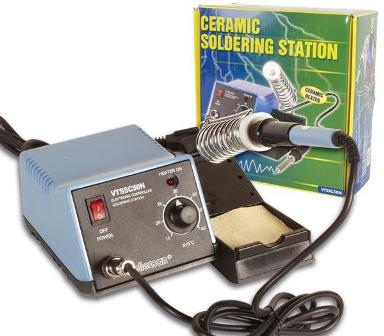Categories: Practical Electronics, How does it work
Number of views: 21071
Comments on the article: 1
Soldering irons and soldering stations
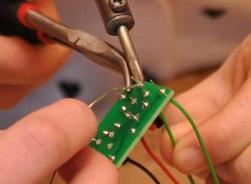 Soldering is the process of joining parts by introducing molten material between them - solder, the temperature of which, as a rule, is lower than the melting temperature of the parts to be joined. The purpose of soldering is to obtain a mechanical connection or electrical contact. Below, we will mainly consider the soldering of electronic components.
Soldering is the process of joining parts by introducing molten material between them - solder, the temperature of which, as a rule, is lower than the melting temperature of the parts to be joined. The purpose of soldering is to obtain a mechanical connection or electrical contact. Below, we will mainly consider the soldering of electronic components.
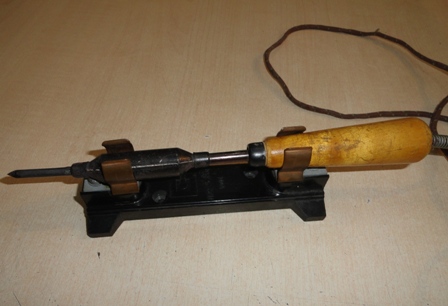
A bit of history
The soldering of metals was used in ancient times. It is believed that this technological operation exists for at least 5000 years. Even when humanity did not know iron and steel, copper, gold and their alloys became widespread. But even then, master chasers used the connection of parts of products using soldering.
Archaeologists have found gold vessels, the handles of which were soldered with gold, as well as alloys of gold and silver. Gold items with traces of soldering were found during excavations of the tombs of the ancient state of Babylon. Scientists dated finds 3200 BC
Brazed jewelry was also found in the Egyptian pyramids. This fact proves that the art of soldering was known in ancient Egypt already in the second millennium BC. The most interesting thing is that the Egyptians did not solder with pure gold, but invented a way to lower the melting point of gold solder.
For this purpose, the gold powder was annealed in charcoal powder. As a result, the surface layer of gold was saturated with carbon (in the technology of metals such a process is called cementation), a gold-carbon alloy was obtained. The melting point of this alloy was slightly lower than that of pure gold. Such solders are called solid.
Soft solders based on tin and lead are mentioned in the writings of the Roman writer and scientist Pliny, the eldest who lived in the 1st century AD. So in the essay "History of Nature" mentions the use of two tin-lead solders - tetrarium (2/3 lead, 1/3 tin) and argentaria (50% lead and 50% tin). The most interesting thing is that such alloys are still used. The first of them is often called a tertiary, and the second half.
During the excavations of Pompeii, which died during the eruption of the volcano Vesuvius, archaeologists discovered lead water pipes, the connection of which was made by soldering tin-lead solders. The same pipes were found at excavations in Libya and Nubia.
During excavations of settlements of the 4th-5th centuries AD on the territory of the upper Volga region, items were discovered, in particular knives brazed with copper. In Kievan Rus, masters soldered locks, keys, knives with copper by brazing, which indicates the high technical knowledge of the masters of those ancient years.
Hand Soldering Soldering Irons
Thus, it can be considered that the soldering of iron, copper and its alloys, as well as aluminum, appeared only after the soldering of precious metals. Later, tools for manual soldering appeared. Such soldering irons were called heaters and heated in an oven.
Later, gasoline blow torches began to be used for these purposes. Heat soldering irons are used to date, and you can buy such a soldering iron even in online stores. The appearance of the heat soldering iron is shown in Figure 1.

Figure 1. Heat Soldering Iron
Electric soldering iron
And only in 1921 an electric soldering iron was created. Ernst Sachs, later the founder of ERSA, received a patent for the invention. Thanks to the inventive enterprise, the electric soldering iron quickly gained worldwide sympathy, being the prototype for creating various designs of soldering tools. It turns out that at the moment the electric soldering iron has a very respectable age of 93 years. The first electric soldering iron is shown in Figure 2.
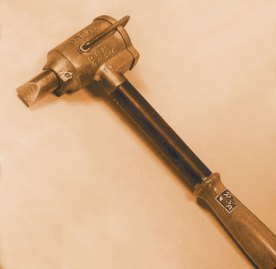
Figure 2. The first electric soldering iron
The soldering iron had the shape of a hatchet, was similar to a heat soldering iron and was intended mainly for tinning work. Similar soldering irons exist to this day. The power of such soldering irons is within 500 ... 800 watts. They are mainly used for soldering large parts, such as automobile radiators, garden watering cans, buckets, etc.
How is an electric soldering iron
The principle of operation of an electric soldering iron is quite simple. Around the soldering rod, which is often called a sting, is a spiral of wire with high resistivity. When passing through a current spiral, it heats up, and the heat received is given to the soldering rod. Naturally, the spiral is isolated from the tip and from the body by a heat-resistant insulator. As an insulator, mica is most often used. This is the classic scheme of a soldering iron that has survived to our times.
Soviet-era soldering irons
In Soviet times, the industry produced many different soldering irons. In amateur radio practice, the EPSN series soldering irons with a power of 25 ... 100W were most often used, and are still used. In the passport attached to the soldering irons, it was written: "The design of the soldering iron is not separable." True, to the credit of manufacturers it must be said that these soldering irons served for a long time. The appearance of these soldering irons is shown in Figure 3.
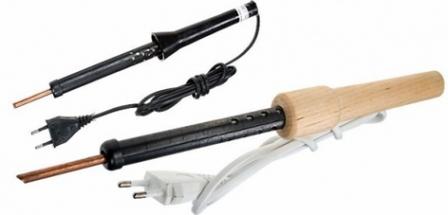
Figure 3. Soldering irons of the EPSN series
But not everything is so bad and harsh. In some soldering irons, the spiral is placed in a ceramic core with a groove, the core, in turn, is inserted into a ceramic cup. A soldering rod is inserted into the central hole of the core - a sting, and no mica. The assembled heater is inserted into a metal case with a wooden handle. The advantage of this design is that it is collapsible, so a spare spiral was sold in the kit.
A little later, miniature soldering irons of the ERA series appeared, with a power of 18 and 25 W, which quickly gained popularity among radio amateurs and telemasters. The appearance of the soldering iron is shown in Figure 4.
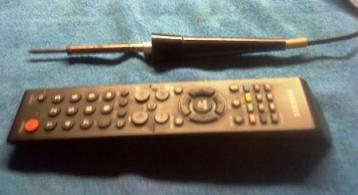
Figure 4. ERA Series Soldering Iron
With the help of such soldering irons, it was quite comfortable to solder transistors, as well as microcircuits in cases like DIP and the like with a pitch of 2.54 mm. To ensure the required soldering temperature, it is advisable to turn on these soldering irons through a thyristor power controller. With this inclusion, the quality of soldered joints mainly depends on qualifications, not even art, the installer.
Chips in DIP packages are already a thing of the past. Now almost all electronic equipment is manufactured using SMD components, the dimensions of which are very small. Therefore, it is difficult to ensure high-quality soldering with the soldering irons described above. Modern soldering irons are used, as a rule, as part of soldering stations.
Read more about soldering stations here:How to choose a soldering station
The heating elements are made of ceramic and have integrated thermocouple, which in combination with a digital display allows you to maintain a given temperature over a wide range, moreover, very accurately. Some soldering irons have thermostats built right into the handle. An example of such a soldering iron is the CT-96 soldering iron manufactured by CT-Tools. The appearance of the soldering iron is shown in Figure 5.
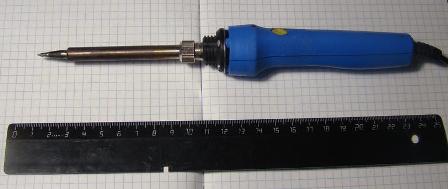
Figure 5. Soldering Iron CT-96
Fig. 6. Soldering station
The soldering temperature depends primarily on the melting point of the solders. During installation and repair of electronic equipment, as a rule, soft solders are used.
Types of Solders
All solders can be divided into two types: hard and soft. Brazing alloys have a high melting point - over 300 ° C, and provide high mechanical strength of the connection. The most widely used are solid PMC copper-zinc alloys and PSR silver-based alloys, which are alloys with different additives.
The melting temperature of the solder grade ПСр-70 780 ° C, ПСр-10 830 ° C, ПМЦ-36 825 ° C, ПМЦ-51 870 ° C.It is obvious that such solders are completely unsuitable for soldering electronic boards.
Therefore, soft solders are used for the installation of electronic circuits, the melting temperature of which does not exceed 300 ° C. Mainly used are tin-lead solders of the POS-61 brand. POS-63, the melting point of which is 190 ° C. These solders are eutectic, that is, they have the same melting and crystallization temperatures.
The name itself speaks about the chemical composition of these solders: POS-61 contains 61% tin, the rest is lead, POS-63, respectively, 63% tin, the rest is lead. These solders are used only for manual soldering and provide good quality solder joints. It was written in the passports of soldering irons: “The soldering should be brilliant, contour”.
POS solders have high electrical conductivity, high fluidity in the molten state and sufficient mechanical strength. The combination of these properties allows for high-quality soldering of printed circuit boards, spring suspensions of measuring instruments, multicore thin high-frequency wires of the Litzendrat type, as well as critical parts made of copper, bronze, brass, steel. When using fluxes for brazing aluminum, aluminum parts are very well soldered, for example, windings of transformers and chokes in household appliances.
In cases where overheating of the soldered parts is extremely undesirable, low-temperature solders are used. One of them is Wood's alloy: tin - 12.5%, lead - 25%, bismuth - 50% and cadmium - 12.5%. The melting point of this solder is only 70 ° C. This temperature is called particularly low. Wood's alloy is also used as an additive to reduce the melting temperature of lead-free solders when soldering parts from printed circuit boards. Such an additive allows you to solder elements without damaging the circuit board and the part itself.
Lead, as you know, is considered a metal poisonous, its vapors are extremely harmful to the human body. Therefore, recently, for soldering electronic equipment, especially household appliances, lead-free solders are increasingly being used. Lead-free solders are a tribute to the requirements of ecology and labor protection.
Lead Free Solders
The most environmentally friendly and safe solder should be considered, apparently, pure tin. It is tin that is used in the food industry for tinning cans - tin. But, unfortunately, annoying flaws are inherent in such a solder. First of all, it is the "pewter plague."
At temperatures below 13.2 ° C, the specific volume of pure tin increases by more than 25%, which leads to the formation of another phase of the substance, the so-called gray tin. Moreover, the lower the temperature, the more intense the conversion process. At a temperature of -33 ° C, tin turns into a gray powder, rations simply crumble. It is clear that such a solder is no good.
But not only rations fall apart. So in 1912, it was the tin plague that caused the death of the expedition of Robert Falcon Scott to the South Pole. The expedition was left without fuel, which leaked through soldered seams in the fuel tanks.
Due to the tin plague, many cultural property, in particular, the collection of tin soldiers, died. For example, in the storerooms of the Alexander Suvorov Museum in St. Petersburg, several dozen tin soldiers simply crumbled into dust due to a breakthrough in heating. This happened in other museums around the world.
To create lead-free tin-based solders, various components are added to it: copper, zinc, silver, gold, indium. These additives allow you to avoid the formation of gray tin, protect yourself from tin plague.
Solders of the following compositions are most often used for soldering electronic components: tin - 52%, indium - 48%; tin - 91%, zinc - 9%; tin - 97%, silver - 2.3%, copper - 0.7%. No harmful metals are observed. The melting point of these solders is in the region of 300 ° C, which is significantly higher than that of tin-lead solders.Anyone who has ever repaired modern electronics knows this very well.
The price for harmlessness is that all lead-free solders have less fluidity in the molten state, and lower wettability of the brazed surfaces. Special fluxes used for soldering with lead-free solders help protect against this drawback. Nevertheless, the quality of the seam made with lead-free solders is worse than when using tin-lead solders. But science does not stand still, research is constantly being conducted to improve the quality of lead-free solders so that the replacement is equivalent.
Many modern microcircuits are available in BGA cases (English Ball grid array - an array of balls). The usual conclusions - the legs of these microcircuits do not. Their role is played by balls of solder deposited on the contact pads in the lower part of the body. For the soldering of such microcircuits, new types of solder appeared - solder pastes applied by the screen method.
Solder pastes consist of several components: the solder itself in the form of a fine powder, solid particles of a flux of the same size. These components become paste due to the presence of binders, especially liquid flux components and volatile solvents.
It is clear that such microcircuits cannot be soldered with an ordinary soldering iron. This requires the use of special soldering methods in which heating is performed by hot air or infrared radiation. For these purposes, hot air or infrared soldering stations are used.
Continuation of the article: Electric soldering irons. Types and designs
See also at e.imadeself.com
:

